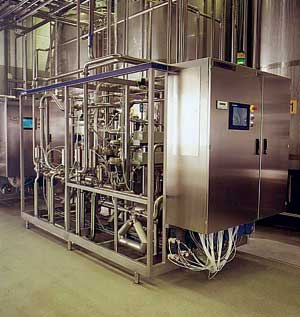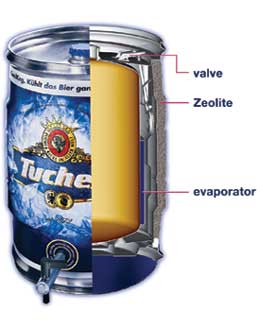
If InterBev exhibits are any indication, batch mixing is becoming an after-thought in beverage processing. In-line continuous mixing & blending systems are gradually supplanting batch tanks, thanks to greater product-handling flexibility, short cleaning cycles that minimize downtime and greater consistency in finished products. The elimination of expensive holding tanks also frees valuable floor space, a welcome change in most plants.
While conversion to in-line blending and mixing is picking up momentum in other parts of the world, “in the U.S., it’s a much slower adoption curve,” observes Paul Snyder, new business development manager with Tetra Pak Inc. As processors respond to beverage consumption trends that favor smaller production runs and more niche products, he expects domestic firms to install in-line systems because of their changeover flexibility.
The latest generation of in-line mix-processing systems handles multiple component streams with minimum product waste, according to Kristina Boee, head of international engineering for Buechen, Germany-based Tuchenhagen Brewery Systems GmbH. She briefed attendees on state-of-the-art in-line mix processing, sugar dissolvers, syrup storage and powder dissolving systems. Dissolution of dry ingredients, including artificial sweeteners, acidifiers and thickeners can be extremely difficult to achieve and costly in a continuous mode, and she provided an overview of a system that uses vertical tanks that employ an optimized central inlet and outlet nozzle.
“With this method, the supplied energy is nearly completely used for the dissolving process,” explained Boee. “Mixing and stirring are reduced to the minimum necessary. Dry substances are added by applying protective gases such as nitrogen or carbon dioxide.”

Batch and in-line systems can coexist. Tetra Pak’s expandable Alblend typically functions upstream from carbonation and de-aeration at a soft drink plant, Snyder says. “It can replace an entire syrup room for the blending process. Accuracy exceeds six sigma at the major bottlers’ plants.”
A centrifugal pump and control valve regulates water coming into the system. Up to seven gas-pressurized lanterns/ balance tanks control more variable components such as sugar, premix concentrates and micro-ingredients. The dynamics of the blending process are isolated from any external processes, and ingredient waste during changeovers and CIP are minimal. The system is expandable, enabling processors to add ingredient streams as dictated by production demands. One processor runs both juices and carbonated products through the system, according to Snyder, and other blended products also could be produced.
Mass flow metering is the enabling technology for in-line blending and mixing. Entrained air has been the Achilles heel of those devices, so the introduction of a digital Coriolis mass meter with a Foxboro CFT50 transmitter that delivers uninterrupted performance during two-phase (gas and liquid) flow is being hailed in some quarters as a significant advancement.
While beverage processors were in Atlanta, Foxboro’s parent, Invensys, was winning the best-of-show award 800 miles away at the Instrumentation, Systems and Automation Society (ISA) exhibition in Chicago. The meter took a curtain call two weeks later when Invensys’ Viatran Corp. subsidiary showcased a 3-A approved flow-tube version called the CFS10 at the IEFP show, also in Chicago.
“Meters die when air is induced, so we reconfigured the Coriolis meter to handle two-phase flow,” explains Viatran’s Steve Stone, flow products marketing manager. “Entrained air is a huge issue for dairies and beverage processors. With the 3A certified sanitary stainless steel flow tube, we expect dairy to embrace this meter immediately.”

Spin the bottle
Of all the particles that can contaminate a beverage, nothing chills a processor’s heart quite like glass. The 17 million bottles recalled from U.S. distribution in 1993 by Heineken N.V. touched off a concerted search for technology that could serve as “a zero tolerance quality tool,” according to Paul Sheppard, technical director of the Insight Systems division of GEI Group Ltd.Infrared, X-ray and nuclear magnetic resonance were among the technologies tested by Heineken, with varying degrees of success, but Insight grabbed the brass ring with an inspection system that relies on LED illumination of glass bottles as they spin at up to 1,200 rpms. Sony industrial cameras are dedicated to each carousel head and capture 16 images per second as the bottles rotate around a 36-head star wheel. A process called image differencing is applied to compare the relative position of any areas of contrast to determine if they are fixed or moving. If they are moving, the program can calculate the likelihood that the particle is glass or some other object and if the bottle should be rejected. False rejects occur about five times per 10,000 bottles, compared to 100 times using the empty bottle inspection method.
While particle contamination is easier to detect with clear liquids, the system can be trained to differentiate between pulp and other natural particles and glass, Sheppard says.
Two Insight machines were installed early this year at Heineken’s plant in Den Bosch, the Netherlands. Because nonreturnable bottles are shipped overseas, the walls of the bottles are thinner and more prone to blistering. Returnable bottles are distributed in the Netherlands, and the system can differentiate between scuff marks and foreign particles, Sheppard says.
The spinning motion agitates the beer and causes bubbles to form. Excessive bubbles indicate an underfilled bottle, and those units also are rejected, he adds. “We did the hard part first with glass detection, but the idea is to add value by building in quality assurance functions, such as underfill detection.”
Approximately 60 percent of the world’s beer is bottled in glass. Kegs are another packaging option, and the world’s first self-chilling keg was on display at InterBev. The technology is licensed to Cool-System Bev. GmbH and is being used by Germany’s Tucher Brau brewery for 20-liter barrels of beer. Japan’s Kirin Brewery will roll out a 5-liter version in 2003.
The key to the self-chilling technology is vacuum pressure and the Zeolite mineral layer that rings the inside of the barrel. The Zeolite is linked by a vapor line to a water-soaked layer of fleece that surrounds a bellow containing the beverage. When a valve is opened, water in the fleece evaporates and transfers heat to the Zeolite, which becomes warm to the touch. The remaining water in the fleece freezes and chills the beverage from 90¿F to 40¿F in 40 minutes and keeps it cold at least 12 hours.
Tucher Brau regenerates the kegs by subjecting them to temperatures 482¿F, causing the water in the Zeolite to evaporate and return to the fleece. A shrink-sleeve around the kegs delivers instructions and marketing messages while protecting users from the activated barrel’s heat. A plant that can produce 150,000 kegs a year comes on line next month, according to Melanie Straub, marketing officer at the Furth, Germany, firm. Campers, caterers and event concessionaires are among the expected end-users.
Better metering
Invensys isn’t the only company upgrading mass flow-meter technology. Most manufacturers have replaced analog transmitters with digital controls, resulting in less noise and vibration and delivering more precise measurement of the fluids being monitored. Endress + Hauser, a Swiss supplier of process control devices with U.S. operations based in Greenwood, Ind., showcased its new Promag electromagnetic flow meter in Atlanta. The unit, which was designed to meet the sanitary needs of food and beverage processing, has a curved flow tube for easy draining. A special gasket design results in a crevice-free connection.Electromagnetic flow meters are unsuitable in some processes. The addition of hop extracts to the wort boiler in brewing is an example because of the low conductivity in the hops. For those applications, a Coriolis meter is better suited to hop dosing. Accuracy to within 0.1 percent of measured value is particularly important when regulating costly ingredients.
Verification of ingredient contents is the role of in-line and on-line quality assurance tools. “Nobody had a very good diet-beverage measurement tool until five years ago,” notes John Dierking, president of Maselli Measurements Inc. in Stockton, Calif. The application of refractometer analyzers changed that, Dierking says, and contemporary analyzers are several magnitudes more precise. Maselli’s IB-04 analyzer, for example, is precise to within 0.001 percent of Brix or artificial sweetener, compared to 0.1 percent a few years ago.
The key is the sensitivity of the refractive index that is used. Light is shined on a prism next to the liquid being analyzed. The angle at which the light changes from reflection to refraction pinpoints the content. Unlike density meters, the analyzer is not affected by shifts in carbonation or by air bubbles.
Infrared absorption is another technology for measuring artificial sweeteners, and OI Analytical introduced its new LAN 9000 for Brix, diet and carbon dioxide measurement at the show. Infrared spectroscopy correlates the harmonics of a liquid going through a tube with its contents, even when minute particles such as aspartame are involved, according to Will Botts, OI’s president.
The College Station,Texas, firm purchased General Analysis Co., pioneers in sugar measurement, three years ago. GAC had developed a diet analyzer, but problems with the device forced OI Analytical to withdraw it from the market and redesign the unit. “Three beta sites have been running for months now with the LAN 9000 and are reporting good results,” Botts says. He is optimistic OI can leverage GAC’s huge installed base of analyzers to regain lost ground.